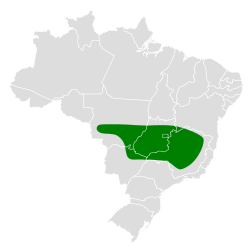| Cinereous warbling finch | |
|---|---|
 | |
| Cinereous warbling finch at Botumirim, Minas Gerais, Brazil | |
| Scientific classification | |
| Kingdom: | Animalia |
| Phylum: | Chordata |
| Class: | Aves |
| Order: | Passeriformes |
| Family: | Thraupidae |
| Genus: | Microspingus |
| Species: | M. cinereus |
| Binomial name | |
| Microspingus cinereus (Bonaparte, 1850) | |
 | |
The cinereous warbling finch (Microspingus cinereus) is a species of bird in the family Thraupidae. It is endemic to Brazil. The term cinereous describes its colouration. Its natural habitat is subtropical or tropical dry lowland grassland. It is threatened by habitat loss.
